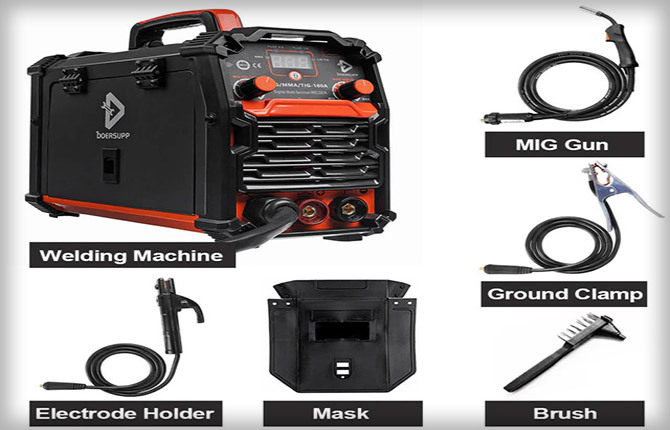Are you planning to zoning the premises? Would you like to calculate a drywall partition before going to the store? Agree, I would not like to order the delivery of one missing sheet of drywall or overpay for extra material.
After spending a little time on preliminary calculations, you can buy everything at once, as well as estimate the cost of the future partition in advance. You will have the opportunity to make adjustments to the estimate and project, or choose another option for the partition, while nothing has been purchased yet.
There are online calculators of materials for drywall structures, but their calculations are very approximate, not suitable for complex partitions. We have classified all types of partitions and will teach you how to calculate the amount of building materials for any of them.
The content of the article:
-
Types of plasterboard partitions
- Variants of form and purpose
- Load bearing and functional characteristics
- The degree of mobility of the septum
-
List of materials and calculations
- Guide profile UD
- Rack profile CD
- Other materials for the frame
- Calculation of drywall for cladding
- Materials for decorative finishing
-
Examples of summary calculation of materials
- Calculation of a solid partition with a door
- Partition with arch and windows
- Conclusions and useful video on the topic
Types of plasterboard partitions
Online calculators will help you calculate the simplest, solid partitions, blind or with a doorway. In a modern interior, plasterboard structures are much more diverse.
They can have complex shapes and additional purposes, in addition to dividing space. Next, we classify, arrange all types of drywall partitions.
Variants of form and purpose
By the presence of openings, partitions are divided into deafrepresenting a solid wall, and openwork. The second category includes not only piers with decorative cutouts of complex shapes, but also those in which there are doorways or windows, shelves.
By location in the room, the partition can be solid - from wall to wall, or discontinuous, with a free end. Also, the discontinuous partition may be low, not reaching the ceiling. For the second type, the design and shape of the end is important.
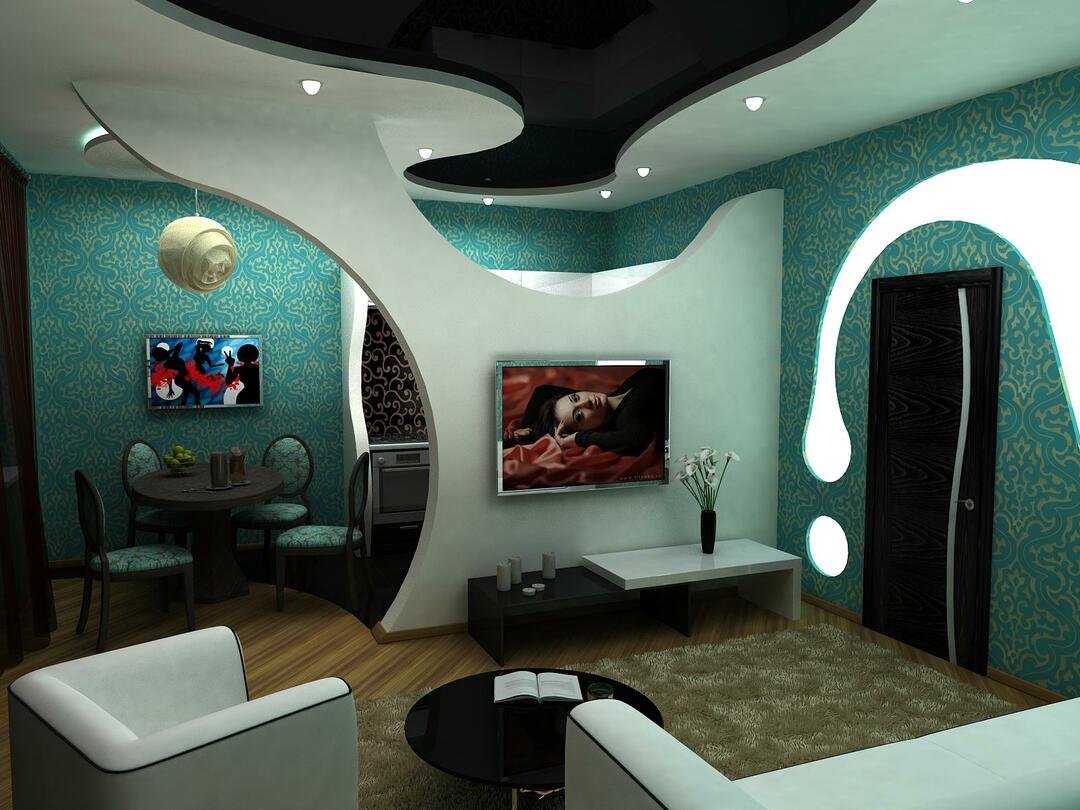
A low partition effectively divides the room into zones, but visually practically does not reduce its volume. Great solution for a studio apartment
Partitions of complex shape are most often discontinuous and openwork.
The most common design solutions:
- wave-curved end;
- through holes for various purposes: with lighting, shelves, windows, cutouts of complex shapes that form a pattern;
- curved plane of the partition;
- built-in sliding door;
- convex semicircular end.
The pliability of drywall allows you to embody the most daring ideas. It is most difficult to calculate the amount of materials for such structures, so a significant amount of waste is inevitable.
Load bearing and functional characteristics
With relative lightness and thinness, drywall has high bearing capacity. If you need to build a full-fledged wall on which you can hang furniture or give another load, use a wider profile, place it with smaller indents, sew the gypsum board in 2 layers.
For solid partitions that completely separate the room, the organization of heat and sound insulation is relevant. Partially this function is also performed by 2-layer sheathing, but more often mineral wool slabs are laid inside the partition, between the profiles.
The degree of mobility of the septum
Basically, structures for drywall are stationary; when installing a sliding door, they serve only as a box in which it hides.
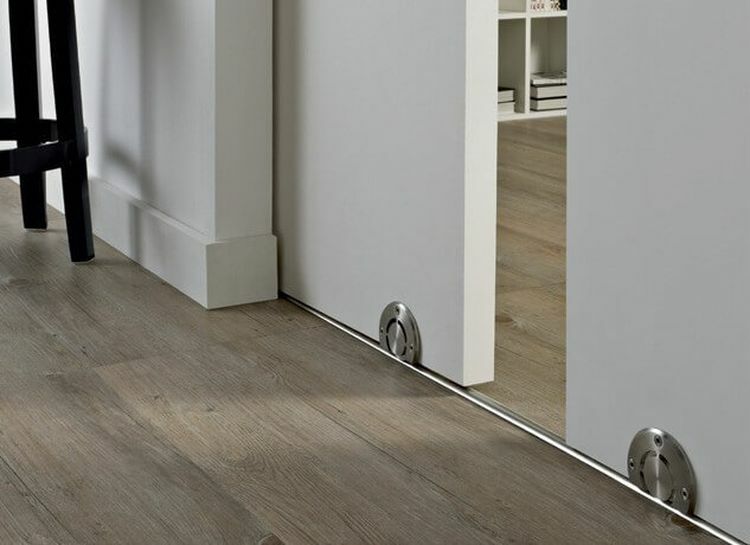
A plasterboard sliding door combines the sound and thermal insulation of an ordinary wall, and the mobility of the door. She instantly changes the layout of the room
But sometimes the moving part can be made of 2 sheets of gypsum board, sewn through a thin profile. This solution is original and functional, but you will need to pick up reinforced guides and rollers.
List of materials and calculations
To calculate the amount of required materials, the first step is to think over the shape of the partition in all details, carefully measure all the parameters, and also prepare drywall cutting tool.
It is advisable to draw partitions of a complex shape on a convenient scale, for example, 10 cm = 1 m.This will make it easier to calculate or measure all the perimeters of holes and wavy lines. In addition, you will see and evaluate the result in advance, you will definitely not get confused during the construction, build exactly the same shape as planned. If you change the project in the process of work, it is impossible to calculate the amount of materials in advance.
The basis of any partition is a frame on which the gypsum board is sewn. As a rule, it is made from steel profiles - it is cheap, fast and reliable. You can use a wooden beam or combine these two materials - the calculation method does not change from this.
Guide profile UD
When calculating the profile for solid partitions, it is important to measure all sides of the perimeter. The geometry of a room is sometimes imperfect, its width in the same place may differ by 3 - 10 cm, as well as its height.
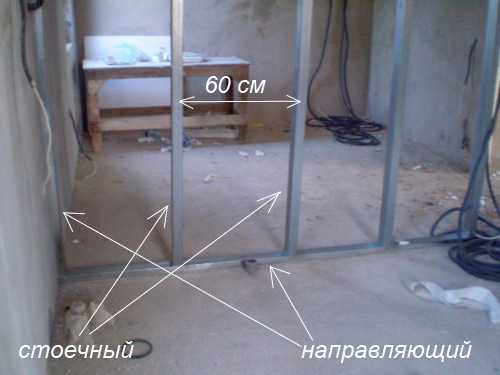
The guide profile has flat, not bent inside shelves - lateral parts. PN is attached to walls, ceiling and floor, PS is inserted into it
When buying a UD profile, decide on its width, because it sets the thickness of the future partition. It can be 50, 75 or 100 mm, that is, the maximum thickness of the partition even with 2-layer cladding is 150 mm. If this is not enough, 2 profiles are laid in parallel, forming a double frame.
For a partition up to 4 m wide and 15 cm thick, 2 guide profiles are sufficient. In other cases, the total footage of the required profile is considered and divided by the standard length of the profile, 3 m or 4 m.
Rack profile CD
The PS is installed vertically, to the entire height of the structure, with a step of 60 cm. So each drywall sheet will be fixed on 3 profiles, along the edges and in the center, and all vertical joints of the sheets will fall on the metal frame. If a structure with increased strength is needed, for example, for hanging furniture, CD profiles are placed every 40 cm, each sheet is fixed on 4 racks.
To calculate the number of racks, it is enough to divide the length of the partition base by the selected step. It is not necessary to calculate the total footage, the length of the CD profile is matched to the height of the partition so as to avoid the need for connection.
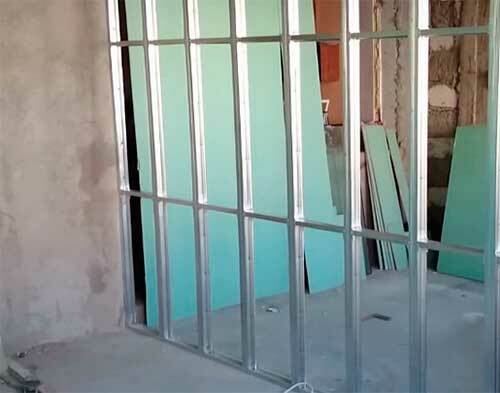
The width of the rack profile must coincide with the width of the PN, so that it is fixed tightly even without self-tapping screws and rivets
For structures with a door or window, the posts should limit each opening on the sides. In practice, the nearest rack, which is in the middle of the sheet, is shifted to the edge of the opening, but it is better to purchase an additional profile. Also, an additional section of the profile will be needed to strengthen the convex part of the end of the partition.
Jumpers are also made from the rack profile. They are necessary in the places of horizontal joints of sheets and holes to secure the edge. To increase the strength of large-area partitions, such jumpers are installed between the posts every 40 - 80 cm.
To calculate how much profile to buy for jumpers for a reinforced frame:
- Calculate the number of horizontal rows of jumpers. Divide the height of the baffle by the chosen step. For example, with a ceiling height of 2.6 m and a pitch of 0.7 m, we get 3.7, rounded - 4 rows.
- Multiply the number of rows by the width of the partition. For example, with a width of 3.5 m for 4 rows, you need 14 m of the CD profile.
- Add 20% to waste, we get 16.8 m.
- Divide by the standard length of the profile. In our example, you get 5 pieces of 4 m or 6 pieces of 3 m.
If jumpers are needed only for horizontal drywall joints, and not for reinforcement, a calculation is performed for 1 row of jumpers.
Add up the widths of all holes to calculate the total length of the webbing that defines the holes or recesses in the bulkhead. Then multiply the resulting number by 2, because the jumper should be both above and below the window.

If the edge of the window is too close to the main rack, vertical jumpers may also be needed, and for a double frame, as on the left in the photo, and transverse ones, between the two walls of the partition
Remember to multiply the number of posts and lintels by 2 when erecting a thick partition on a base of 2 parallel guide rails.
Other materials for the frame
The profile must be attached to the wall, floor and ceiling every 30 - 50 cm. For this, dowels or long wood screws are used, depending on the material of the walls.
To calculate their number, multiply the perimeter of the abutment of the partition to the bases by 3. For example, for a solid partition 2.6 x 3.5 m, you will need (2.6 + 2.6 + 3.5 + 3.5) x 3 = 37 pcs.
A damper tape should be laid between the profile and the wall, along the entire perimeter. The required length is equal to the perimeter of the abutment.
To fasten the profiles together, a special tool is used - a cutter. If not, buy small self-tapping screws for metal. You will need to prepare 4 pcs for each rack and each jumper.
For the doorway, it is recommended to reinforce the uprights and lintel with wooden beams. The cross-section of the timber is equal to the profile width, usually 100 mm.
There is a special arched profile to form the curved lines of the end face or hole. But it is not always on sale and is expensive, so it is often made independently from PN or a ceiling guide profile.
The number of such a profile corresponds to the total length of all curved lines.

It is easier to bend and fasten a profile of smaller width on your own. When choosing a narrow profile, buy it 2 times more, for attachment to each side of the partition.
Sound insulation is usually done with mineral wool 50 or 100 mm thick. It is sold in slabs or rolls 60 cm wide, therefore it is conveniently located between the profile posts. The total area of the cotton wool is equal to the area of the partition.
To achieve maximum sound insulation, a partition is made on a double frame with 2 layers of insulation, leaving a gap between them. If you add 2-layer plasterboard cladding, sound insulation will be 3 times better than with 1 layer of 50 mm cotton wool and 16 times better than without it at all. True, the cost of such a partition doubles.
Calculation of drywall for cladding
There are two ways to calculate the required amount of drywall: by total surface area or drawing up a layout and cutting of sheets.
The first method is universal; it is much faster and easier. The second method, more precisely, allows you to minimize the amount of waste, and the resulting plan helps in the process of cutting and installing the material. But you need to draw up a diagram for each case individually.
First of all, you should calculate the surface area of the partition by multiplying its height by its width. The resulting number is multiplied by 2, because the partition is sheathed on 2 sides.
For structures with irregular shapes, for example, with an uneven end, take the largest value for the width and height. The cuttings will turn out to be of an irregular shape, so they cannot be used in further work.
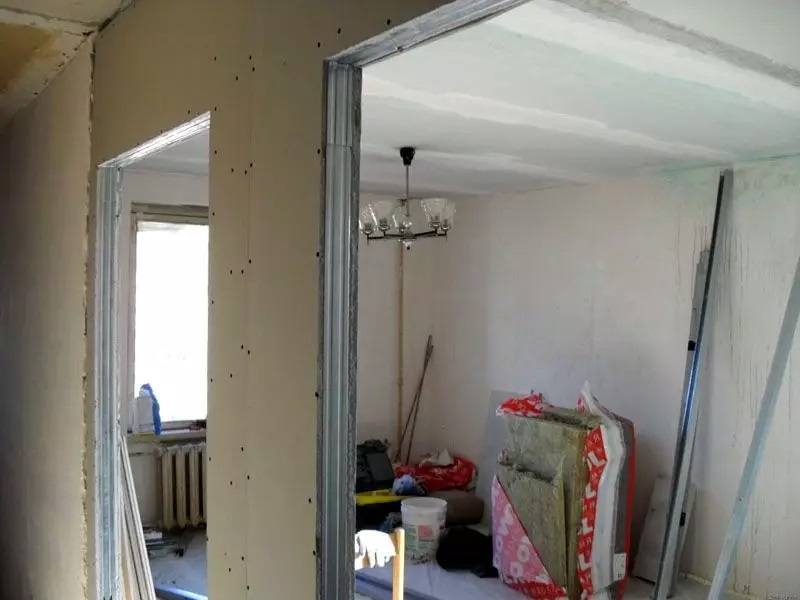
Only parts of the gypsum board cut from doorways can be useful for partitions with a height of more than 2.5 m, where the length of a standard sheet is not enough
For a solid blank partition, a wall with a door or window, these are all the necessary calculations. That is, in order to fence off a 3.5 m wide room with 2.6 m ceilings, you will need 3.5 x 2.6 x 2 = 18.2 sq. drywall. Taking into account the standard dimensions of the gypsum board 1.2 x 2.5 m, with a margin for trimming 15%, you need to buy 7 sheets.
For reinforced, 2-ply sheathing, multiply this number by 2.
For discontinuous and openwork partitions, you should additionally count drywall for sheathing the end and walls of holes, shelves. At the same time, keep in mind that only flat, straight segments should be included in the total area.
For curved elements, you should buy an arched drywall, 6.5 mm thick, or at least a ceiling one, 9.5 mm thick. When creating an arch, only its curved part is measured; smooth slopes can be sewn up with the drywall that is cut from the opening.
To calculate the amount of arched drywall, measure or calculate the total perimeter of all curved holes and the end using the formulas.
For example, the perimeter of a circular cut is 3.14 times the diameter of the circle. Then multiply the resulting footage by the thickness of the partition, expressed in meters - this is how you calculate the total area. Add 20 - 40% to it for trimming, reinforcing shelves and unsuccessful bending attempts.

As practice shows, 1 standard sheet of arched drywall is enough for sheathing curved elements of 1 - 2 partitions of complex shape
In the same way, you can calculate the amount of drywall required to finish holes with even edges, for example, rectangular ones. In this case, the resulting number is added to the total area of the gypsum board, because here you can use a material with a thickness of 12.5 mm.
If you decide to carry out the calculation by drawing up a layout diagram and cutting sheets, please note that the most common drywall is 1200 x 2500 mm, but sheets of other sizes are also available.
GOST 6266-97 “Plasterboard sheets. Specifications "allows products from 2 to 4 m in length, 60 or 120 cm in width. Using them, you can save money, reduce the amount of pruning.
On the diagram, place the horizontal joints of adjacent sheets apart. When cutting a thin sheet, note that the drywall is bent along the length of the sheet. Buy material with a margin in case the sheet breaks during cutting, bending, or fixing.
In addition to the drywall itself, do not forget to buy self-tapping screws to fix it. Each sheet is screwed along the perimeter, in increments of 20 - 40 cm, plus to 1 or 2 racks in the middle.
About 30 pieces are needed for 1 whole sheet. For curved and small elements, the fixing step is reduced to 10 - 15 cm, and for the 1st layer of double sheathing, it is increased to 40 - 60 cm.

The more small and curved parts in the drywall construction, the higher the consumption of self-tapping screws per 1 sq. M.
For simple deaf partitions, take 20 - 25 self-tapping screws per 1 sq. partitions, for complex shapes - up to 80 - 100 pcs / sq.m.
Materials for decorative finishing
After installing all the drywall parts, the partition must be given an elegant, finished look.
For this you will need:
- reinforcing mesh-serpyanka - along the length of all joints of the sheets;
- primer - for the entire structure area, consumption depends on the manufacturer, indicated on the package;
- starting putty - for sealing joints and caps of self-tapping screws;
- finishing putty - about 600 g per 1 sq. area;
- corner profile, metal or plastic, flat and arched, plain or reinforced with mesh. The total length along the perimeter of the holes plus the length of the end, multiply by 2.
- Top coat: paint, wallpaper, tiles, decorative plaster, or a combination of these. If necessary, glue.
Consumables can also include fine sandpaper for sanding the putty before painting or pasting.
Examples of summary calculation of materials
To show all the calculations clearly, let's take 2 common design options, the simplest and most complex.
Calculation of a solid partition with a door
Let's take the most common simple option: the partition that separates the new room is 4 m wide, the ceiling height is 2.5 m, the door is 2 x 0.8 m.
The UD guide profile is needed around the perimeter of the partition. For this option, it is convenient to use 2 pieces of 4 m and 2 pieces of 3 m.
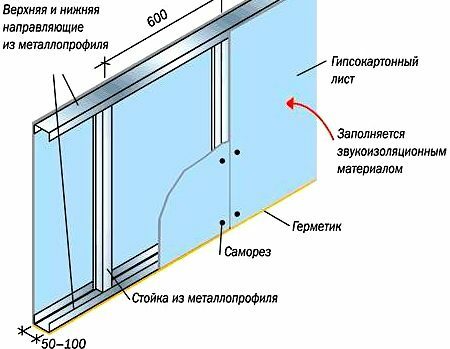
The profile width sets the thickness of the future partition, determines the maximum thickness of mineral wool, but does not affect the amount of required materials
A sealing tape for the profile is needed around the entire perimeter. 2.5 + 2.5 + 4 + 4 = 13 m.
Dowels for fixing the profile are needed 3 pcs per 1 m of the perimeter, 13 x 3 = 39 pcs.
The CD rack profile for such a partition can be used in 2 options: only racks with a pitch of 40 cm or racks with a pitch of 60 cm, reinforced with horizontal bridges.
For the first option, you will need 4 m / 0.4 m = 10 pieces of a profile of 3 m each +1 spare. For the second case, you need 4 m / 0.6 m = 7 pieces of racks of 3 m each.For jumpers located with a step of 65 cm, you will need 2.5 / 0.65 = 4 rows of 4 m each, that is, 16 m of the profile. With a margin for waste, you need to buy 5 pieces of a 4-meter-long profile.
To reinforce the profile around the door, a bar with a section of 100 x 100 mm, with a total length of 2 + 2 + 0.8 = 4.8 m, is desirable.
Mineral wool for sound insulation is laid over the entire area of the partition: 2.5 x 4 = 10 sq. M.
Plasterboard needs to sheathe the entire area from 2 sides, 2.5 x 4 x 10 = 20 sq. M. or 7 standard sheets of 3 sq.m.
Self-tapping screws for fixing drywall - 30 pcs per sheet or 210 pcs in total. Serpyanka tape on all joints of drywall sheets: 7 seams of 2.5 m = 17.5 m. a little, 3 kg of packaging will be enough, and the finishing one needs 0.6 kg per 1 sq. m, only 0.6 x 20 = 12 kg.
Partition with arch and windows
It is better to calculate complex structures after drawing up a drawing. Let's count the materials for the partition from the drawing in the picture.
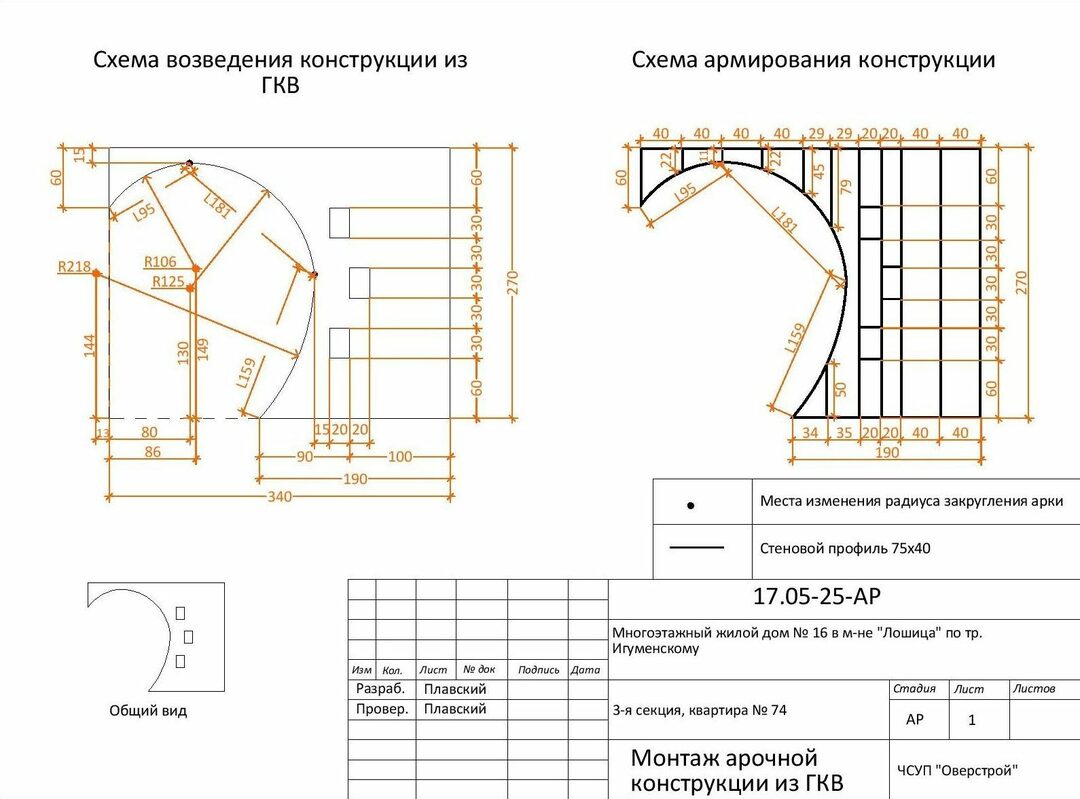
You can draw up a drawing, perhaps less beautiful, but just as functional. It is more convenient to do this on a sheet of paper
UD profile - 1 piece 4 m long and 2 pieces 3 m each. Sealing tape needs 0.6 + 3.4 + 2.7 + 1.9 = 8.6 m.
CD profile - 4 whole racks + sections 0.22 + 0.11 + 0.22 + 0.45 + 0.79 + 0.5 = 2.29 m. Jumpers are also needed top and bottom of each window: 0.2 mx 6 pcs = 1.2 m. In total, you should buy 4 profiles of 3 m and 1 pc of 4-meter.
An arched profile or additional CD is needed for the entire length of the curved line. You can roughly calculate the length of half a circle of average radius, 125 mm. 1.25 x 3.14 x 2 = 7.85 m = full circumference, that is, the length of its half is 3.92 m.
Our arch is slightly more than half the circumference, so you need to buy 2 profiles of 3 or 4 m each.The drawing shows the exact calculations of the length of each section of the arch, in total - 435 cm.
Regular, 12.5 mm drywall is needed for the main plane and window cladding. For most of the partition, you need 1.9 x 2.7 x 2 = 10.26 sq.m. For the top piece, you need 1.5 x 0.6 x 2 = 1.8 sq.
The thickness of the partition will be 75 + 12.5 + 12.5 = 100 mm. The perimeter of the windows is: (20 + 20 + 30 + 30) x 3 = 300 cm. For their sheathing you will need: 3 x 0.1 = 0.3 sq.m. In total, taking into account the stock for trimming, you need (10.26 + 1.8 + 0.3) x 1.2 = 14.8 square meters, that is, 5 sheets.
Arched or ceiling drywall is needed for the curved butt strip. It has dimensions of 435 x 10 cm, that is, you need less than 0.5 square meters of drywall.
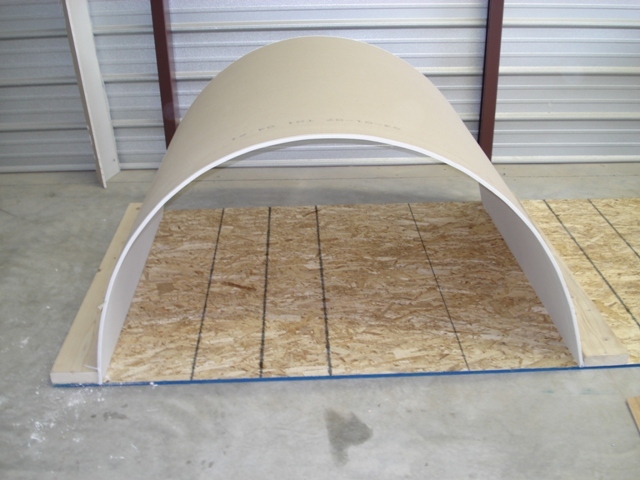
For curved elements, it is especially important to provide a stock of material. In this case, even a narrow sheet, 2500 x 600 mm, will provide a sufficient margin
To strengthen the corners of the arch and windows on both sides of the partition, a special profile is needed. In total, 4.35 x 2 = 8.7 m of the arched corner and 3 m (the total perimeter of the windows was calculated earlier) x 2 = 6 m of ordinary corners.
You will need much more self-tapping screws than for a simple partition, about 50 pcs for each drywall sheet. In total, we have 6.5 standard sheets, this is 325 self-tapping screws.
Also, our other article may be useful to you, where we tell in detail how install sockets in drywall.
Conclusions and useful video on the topic
The easiest way is to calculate the required amount of materials for a solid blind partition or wall with a door. However, knowing some of the subtleties and spending a little time, it is possible to independently calculate how much to buy even for the most complex openwork partition. For example, for something like this one:
How to calculate a metal profile for any drywall construction is shown in this video:
If you carefully carry out all the calculations, you can fairly accurately estimate the cost of materials for the future partition, save money on their purchase and facilitate the installation process.
Have you installed a drywall partition? Did you make preliminary calculations of building materials? Share your experience in the communication box below the article. There you can also ask questions of interest on the topic, and our specialists will try to answer them promptly.
